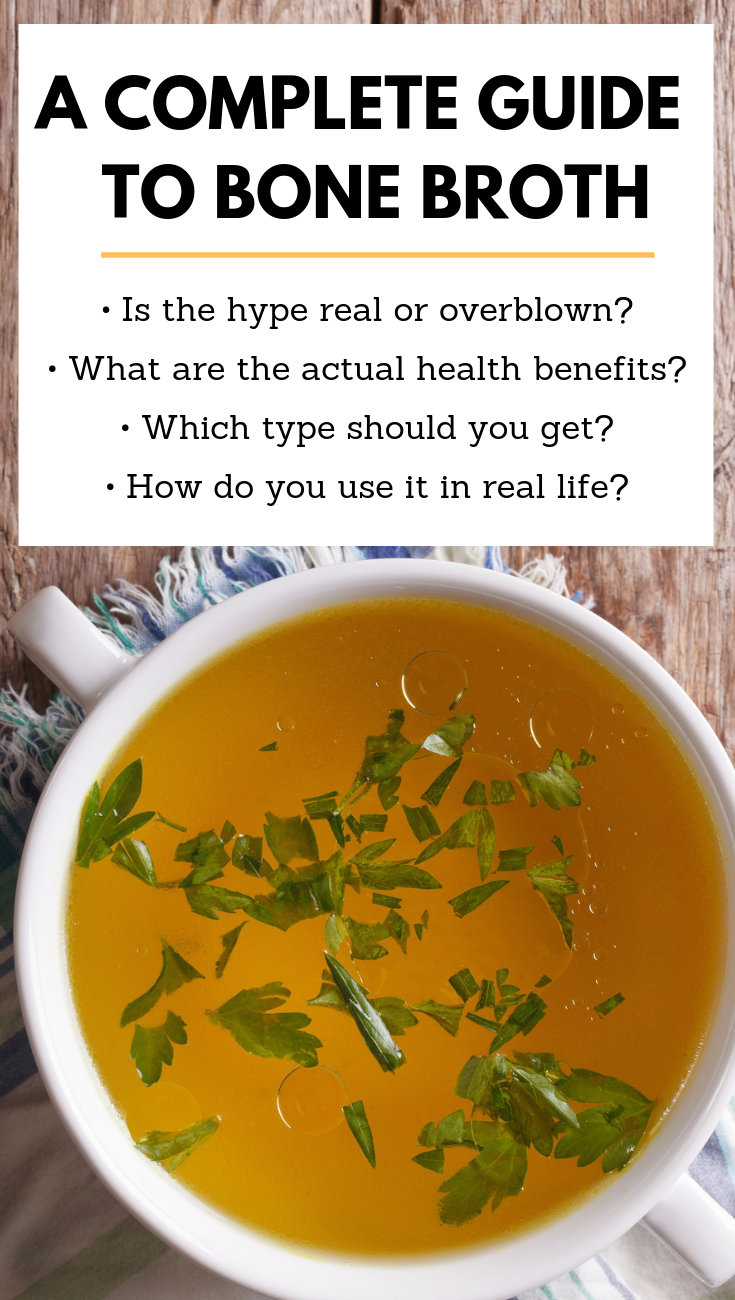Does it seem like bone broth is popping up more often in your feed or on specialty food shelves? Curious about what the deal is and where it came from all the sudden? Well, you’re in luck, because I put together a convenient FAQ all about bone broth - including what it is, how it’s different from stock, and what are the health benefits. Here are my answers to your most pressing bone broth questions:
What is bone broth?
Bone broth is exactly what it sounds like. A long-simmered broth made from animal bones, and usually some herbs and/or vegetables. It's made from the bones of chicken, fish, beef, lamb, pork, or a mixture.
Is bone broth a new trend?
Actually, no. Bone broth is having a resurgence in popular culture, but it’s been around for a long, loooong time. It’s been consumed for it’s nourishing health benefits for centuries in cultures all around the globe. It’s been used since the 12th century in Egypt, and even before that in China.
How is bone broth different from stock?
This confuses a lot of people and is a common question. Bone broth vs. broth vs. stock. We often use the terms interchangeably and they’re similar, but each a little different.
Regular Broth: Has a thin, watery consistency. It’s made mostly from meat scraps (or veggie scraps), and sometimes is made with small pieces of bone. Occasionally it will have additional herbs and spices in it. But you cook it for a much shorter time. When you see veggie broth or beef broth on sale in the supermarket, this is usually what they’re selling.
Stock: Made by cooking bones (along with ligaments and connective tissue), in water for approx 2-4 hours. Again, sometimes vegetables or herbs/spices are added.
The longer cooking time helps extract beneficial compounds like gelatin and collagen from the bones. The gelatin causes the stock to be more thick and rich (maybe even becoming like jello when refrigerated).
Bone Broth: Actually much more similar to a stock than a broth. Like stock, you make it by boiling bones, but simmer it for a much longer time. It usually cooks between 12 and 48 hours. Because of this, even more nutrients are released from the bones, including more gelatin, so it has a thicker texture than either broth or stock.
What ARE the beneficial nutrients in bone broth?
Everyone says bone broth is good for you, but why? What specifically does it contain that makes some people refer to it as “liquid gold”?
Collagen:
Collagen is the most abundant protein in the body, comprising about 30% of our total protein.1
It’s found mainly in skin, joints, bones, tendons, ligaments, and cartilage and it gives our tissue structure. Sometimes, people refer to it as the glue that holds our body together.
Gelatin:
Gelatin is essentially what you get when you cook collagen for a long time. This is what gives bone broth it’s jello-like consistency when refrigerated. Great for digestion and very soothing for the gut!
Amino acids:
Bone broth contains 17 different amino acids, which are the building blocks of proteins in the body. Amino acids are essential for building muscle and encouraging wound repair, along with many other functions. If we don’t get enough, we can see fertility issues, poor immune function, and digestive problems.
Two of the amino acids bone broth is particularly rich in are glycine and proline.
Glycine:
Glycine is a tiny amino acid that packs a big punch. It helps with many bodily processes, including digestion, where it’s involved in the breakdown of fatty acids in the food we eat.2
Glycine helps the body produce serotonin, which has a significant impact on sleep and mood.
It also helps to regulate blood sugar levels, and move glucose to cells and different places in the body. Normal blood sugar is important for energy levels and brain health. It’ll also help prevent long-term problems like heart disease, nerve problems, or diabetes.
Proline:
Proline is another amino acid with a myriad of health benefits.
It’s an important player when it comes to repairing wounds and joints, as well as forming collagen and connective tissue. It can also help to heal a damaged gut lining.
Proline also helps protect our bodies against oxidative stress and free radical damage, as well as assisting in metabolizing food.3
Additionally, it’s helpful for heart health because it helps strengthen and maintain heart muscles.4
There are more (glutamine, glycosaminoglycans, etc), but I don’t want to turn this into a 10-page encyclopedia article and you have places to be and things to do.
Why should I consume bone broth?
Are there really that many health benefits to consuming bone broth? Honestly, yes. This is why people won’t shut up about it on the internet. This is also why people all over the world have consumed it for thousands of years.
Bone broth can benefit many different systems and parts of the body, including:
Digestive Health:
Bone broth is one of my absolute favorite foods to recommend for improving the health of your gut. The gelatin and collagen are extremely healing to the gut and help support intestinal integrity and health. Additionally, low collagen levels have been associated with inflammatory bowel disease.5 The amino acids it contains are also key for decreasing inflammation in the gut.
A healthier gut can have wonderful downstream impacts on your health, like reduced food sensitivities, more balanced hormones, and decreased digestive symptoms.
Joint Health:
Joints are full of collagen and cartilage, which starts to decrease as we age and succumb to wear and tear. Almost every component of bone broth can have a positive impact on joint health.
The gelatin and collagen in bone broth help restore cartilage and offer building blocks for strong bones.
Compounds like hyaluronic acid, glucosamine, and chondroitin (aka glycosaminoglycans or GAGs) are key for joint lubrication. They’re important for a full range of motion and bone broth is chock full of them.
Bone broth is actually becoming a popular drink among athletes to help keep joints mobile and speed recovery.
Immune Health:
Bone broth has been used for a very long time to help boost the immune system. What do you do when a friend or family member is sick? You bring them soup! This isn’t just some polite tradition, it actually works. In a recent study, chicken soup helped symptoms of upper respiratory tract infections.6 Bone broth’s positive effect on the immune system is likely a downstream benefit of improved gut health and decreased inflammatory signals.
Skin Health:
Gelatin is important for the process of skin cell renewal, skin elasticity, and tone. Combined with glycine, it can help protect skin from UV light damage and reduce damage from free radicals.7,8
As we age, we lose collagen, which affects the appearance of skin and wrinkles. Gelatin (which is basically a more broken down and easier to digest form of collagen) can help repair and stimulate new collagen growth.
Sleep + Mood:
One thing I recommend for clients who are having a hard time sleeping is to have a cup of bone broth before bed. It’s rich in glycine, which is an amino acid that functions as an inhibitory neurotransmitter. This means it stops our brains from becoming over-active and enables the mind and body to unwind and relax.
Some people report it helps with sleep quality and increases time spent asleep when in bed.9
Deficiencies of inhibitory neurotransmitters appear to be involved in the development of anxiety disorders, so glycine can help here too. It also helps the body produce serotonin, which can improve sleep and mood.
How do I use bone broth?
Bone broth is the secret weapon of many professional chefs. It adds a savoriness and depth of flavor to foods that you just can’t get with water. That’s one reason food tastes better when you eat out (plus all the extra butter and salt, but you get the idea).
My favorite ways to incorporate it into my diet are:
- Use as a base for soups and stews
- Use as cooking liquid for rice
- Cook vegetables in it
- Substitute for water in most recipes
- Heat it up and drink a cup of it (I know it sounds weird, but sometimes tea gets tiring, and you want something warm and savory).
What kind of bone broth is best?
Does it matter what kind of broth you get?
In terms of the animal, not really. They all are similar with slightly different benefits - e.g. chicken broth has more protein, beef broth has more minerals. Chicken bone broth definitely has the lightest taste, while broth from beef or lamb bones is richer with a stronger flavor. Try them all out and see what you like best.
In terms of quality, absolutely. There’s been some concern in the past that toxic metals may leach out of animal bones when cooking and contaminate the broth. The analysis that looked at this actually found that the amount of lead that leached out was still well below the EPA’s safe upper limit. However, to be on the safe side, you should always get bones or bone broth made from pasture-raised animals. Animals raised on smaller farms, far from industrialized areas will have a lower risk of toxic environmental exposure.
If you buy bone broth instead of making it, be sure to avoid any that comes in cans - these are lined with BPA, which is an endocrine disrupter that can cause many health problems, including cancer.
Now you know all the details about bone broth and why it’s so popular, you’re set to go! Bone broth can now become a regular part of your diet - connecting you to a rich food history as well as adding delicious flavor and wonderful health benefits to your life.
If you're interested in making your own, check out this recipe I made with instructions for the Instant Pot, slow cooker, and stove top.
Any more questions? Feel free to ask them down below in the comments.
Pin this post for later:



Leave a comment!